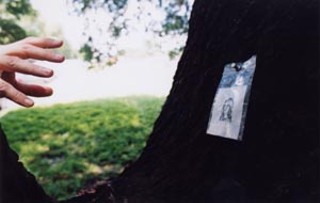In Search of the Wild Art
'Cracks in the Pavement' leaves art in unexpected spaces throughout the city
By Robert Faires, Fri., June 18, 2004

Where does art belong?
We associate it with museums and galleries, rooms enclosed by walls where art is hung or placed specifically to be viewed. But that treats works of art somewhat like animals in a zoo, isolating them in an environment constructed for the explicit purpose of human observation and reflection. It's where we've come to expect art to be, and how we view it there plays off those expectations. So what happens when art is released to the wild, where viewers might encounter it among the bustle of city life?
That's what a new project called "Cracks in the Pavement" is trying to find out. Six local artists created more than 100 art objects for specific sites all over Austin – beneath bridges, beside freeways, along sidewalks, up in trees ... whatever spots they found interesting – and earlier this month, they put them in place to be discovered by, well, anyone. Some pieces are in heavily trafficked areas where they might easily be spotted while strolling down the street or crossing a creek. Others are hidden or set in more secluded locales, but the artists have provided a means for finding them, via a Web site, www.cracksinthepavement.com. On it are maps of the city with clues to each object's location.

Intrigued by the project, I determined to go hunting for some of this wild art. First, I studied the project Web site's maps for sites near the Chronicle. Clicking on the area north of the UT campus pulled up a meticulously hand-lettered map of the neighborhood by the Hancock Recreation Center on which were three red dots. Clicking on a dot brought up a page for the object at that site – in this case, one of Dane Larsen's 10 works in a series titled Taxodium distichum, set along Waller Creek – with a photo of the upper limbs of a cypress tree where the work could presumably be seen. A link there led to a page on which Larsen provides some illuminating background on his work (but no pictures or descriptions of the art objects, alas). Returning to the map, I learned that the other two dots were also part of Larsen's series – more sites on Waller Creek, more photos of cypress trees.
Curious to see how works by the other artists were represented, I went back to the Austin map and clicked on more dots. One on Speedway at 27th Street turned up On Water, Site 1, by Katherine Bash, with a photo of a footbridge. Her background page cites the importance of water in her work and describes her creations here as "pauses along a path." One by the Carver Library and Museum led to a site for Jacob Borndal, with a photo of a sidewalk pointed toward a sign that reads "FISH-R-US." A note below this states that near this site Berndal has set 10 different objects, which he openly admits are keys. A dot by I-35 south of Cesar Chavez Street locates Anonym, Site 9, by project organizer Heather Johnson. The photo shows a view of the freeway through the forking limbs of a tree. On Auditorium Shores is the dot for Chris Taylor's Drifting Declination: changing by OD 5' West/year, depicted with a shot of Town Lake. The title and text on the background page suggest a compass is involved. A dot way south, where Bilbrook Place passes Silcantu Drive, marks a site of Alia Hasan-Khan, whose eight objects in the Crossing Points series ring the outer edges of the city. The photo for it shows a tree-lined suburban street. The background page refers to drawings "traced from photographs of Mexican immigrants being arrested at the Southwestern borders of the U.S."
Armed with a better sense of where these artists were coming from, I felt ready to seek out what they'd left behind. Since I wouldn't have the Web site with me for easy reference, and since the maps, while detailed, still covered a substantial area, I scribbled some notes that might help me identify each specific location. With two of Dane Larsen's sites shown on Waller Creek between 41st Street and Park Boulevard, I felt I might double my chances for success and headed for them first.
North of the Hancock golf course, Waller winds through the Sri Atmananda school campus, where I quickly realized that there were more than a few trees on the banks of the creek, and recognizing the ones I'd seen on the Web site wouldn't be that simple. Still, I spent a few moments walking beside the creek, looking up, down, and around for anything that might look like, um, art. I saw stout trunks with dozens of branches radiating outward from them and green curtains of leaves layered around them. I saw water lazily lolling over earth and stones, occasionally casting off diamond shards of light. I saw shadows in a thousand shapes. I just didn't see any art – at least, man-made art.

It occurred to me that the heavy weather of the previous few days might have washed these works far from their original locations. A later conversation with Heather Johnson confirmed that the rains had displaced some objects. Concern over that led her to some days of "intense dismay that all these things were gone," really before the project had had a chance to begin. But when the sun returned, Johnson took an inventory of several sites and discovered to her surprise that "quite a few" objects were still in place. One had clearly vanished: Chris Taylor's floating compass on Town Lake. But in its place Johnson found "all these other things washed up on the shore" that caught her eye and made her reconsider the world around her.
That, you see, was the real aim of the project: to call our attention to "small details and 'in-between' spaces encountered throughout everyday life," as it says on the Web site. "I wanted to encourage people to engage with the environment on an intimate level," Johnson told me, "to get out of their cars and walk around and look at what's around." What you see while searching for these hidden artworks might be every bit as interesting and rewarding and artful as the objects left by the artists: a bird's nest, an urban garden, a sunset through concrete pillars, a neighborhood you'd never seen.
That was what I was discovering in my search. I left the Sri Atmananda campus and headed to Speedway and 27th, where no footbridge like the one on the Web site was evident. So I began hiking along a creek up toward Adams-Hemphill Park. Sure enough, there was the bridge, which I crossed three or four times, scanning its metal beams, peering through its wooden slats for anything resembling an art object. I didn't see one. What I did see, though, were downed limbs, dark lines of silt showing how high the creek had risen, a T-shirt impaled on a branch – evidence of the week's storms, which, viewed in this unfamiliar setting, gave me a new connection to the force of nature we'd experienced that week. It also left me convinced that nature had carried Katherine Bash's object, whatever it was, to a new site where I was unlikely to find it.
So off I headed to one of Heather Johnson's sites, the one by I-35, south of Cesar Chavez. The photograph that Johnson provided gave me some of the most specific visual clues I'd had all day: a forked tree trunk, a chain-link fence around construction, a view of the freeway. At the intersection of East Avenue and Lambie, I began walking from tree to tree, trying to find the same visual orientation as in the photograph. Nothing seemed right. Then I realized I was north of Lambie Street, not south of it as the map indicated. Moving toward Town Lake, I spotted the tree, and as I approached it, I could see something tacked in the "V" of its trunk: a small plastic bag containing a white cloth onto which was hand-stitched the face of a woman. I can't say why exactly, but the sight of it was quite touching. Perhaps it was because I had been searching so far without success; perhaps it was how out of place it appeared, this carefully crafted portrait affixed to this ancient oak surrounded by cars, condos, and concrete. I don't know, but I was moved. It was then that I truly understood the project's full title: "Cracks in the Pavement: Gifts in the Urban Landscape." This piece felt like a gift.
Johnson knows that other objects have been found, as this one was. In checking on one she had left on the embankment of I-35 near 32nd Street, she discovered a business card left in its place. On the Web site, people can report finding objects, and some have. Now, Johnson is encouraged that the project will play out the way she and her collaborators envisioned. That bodes well not only for Austin, but for London, England, where "Cracks in the Pavement" will continue next month as part of the London Biennale, a free, do-it-yourself art festival for any artist who wants to take part. Beginning July 30, works by Johnson and her Austin team will be spread around London, with the same Web site offering maps and clues to their locations and information about them once they're found. And Austinites can follow the progress of this sister version even as they track the progress of the project in their hometown.
The objects may be kept by whoever finds them, and the thought of holding onto Johnson's delicately stitched portrait is tempting. But having gone through the process of searching for these works and having experienced the wonder of finding one, this handcrafted bit of human expression set so incongruously among the concrete and asphalt, the leaves and limbs, I prefer to return it to its place. Let another enjoy the discovery of art in the wild. Someone else could surely use this gift.
Cracks in the pavement. They're out there, waiting to be discovered. ![]()
"Cracks in the Pavement: Gifts in the Urban Landscape" will continue in Austin through Aug. 29. Another part of the project will be launched in London, England, on July 30, in conjunction with the London Biennale 2004, a free art festival running through Aug. 29. For info, visit www.cracksinthepavement.com.










